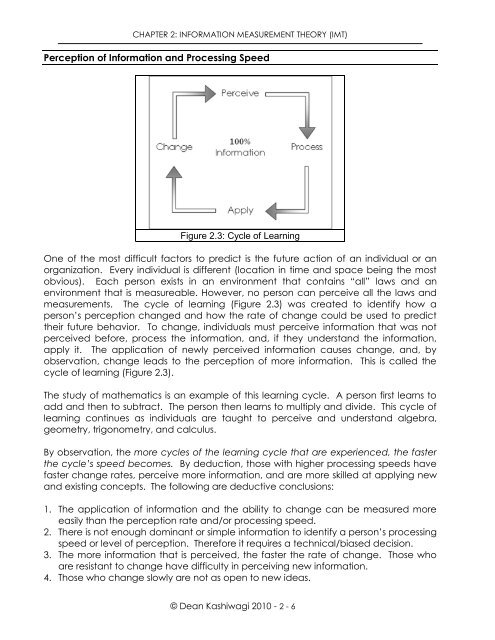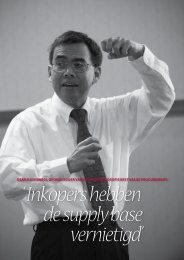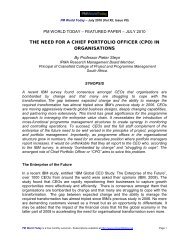Information Measurement Theory (IMT) - Performance Based ...
Information Measurement Theory (IMT) - Performance Based ...
Information Measurement Theory (IMT) - Performance Based ...
Create successful ePaper yourself
Turn your PDF publications into a flip-book with our unique Google optimized e-Paper software.
CHAPTER 2: INFORMATION MEASUREMENT THEORY (<strong>IMT</strong>)<br />
Perception of <strong>Information</strong> and Processing Speed<br />
Figure 2.3: Cycle of Learning<br />
One of the most difficult factors to predict is the future action of an individual or an<br />
organization. Every individual is different (location in time and space being the most<br />
obvious). Each person exists in an environment that contains “all” laws and an<br />
environment that is measureable. However, no person can perceive all the laws and<br />
measurements. The cycle of learning (Figure 2.3) was created to identify how a<br />
person‟s perception changed and how the rate of change could be used to predict<br />
their future behavior. To change, individuals must perceive information that was not<br />
perceived before, process the information, and, if they understand the information,<br />
apply it. The application of newly perceived information causes change, and, by<br />
observation, change leads to the perception of more information. This is called the<br />
cycle of learning (Figure 2.3).<br />
The study of mathematics is an example of this learning cycle. A person first learns to<br />
add and then to subtract. The person then learns to multiply and divide. This cycle of<br />
learning continues as individuals are taught to perceive and understand algebra,<br />
geometry, trigonometry, and calculus.<br />
By observation, the more cycles of the learning cycle that are experienced, the faster<br />
the cycle’s speed becomes. By deduction, those with higher processing speeds have<br />
faster change rates, perceive more information, and are more skilled at applying new<br />
and existing concepts. The following are deductive conclusions:<br />
1. The application of information and the ability to change can be measured more<br />
easily than the perception rate and/or processing speed.<br />
2. There is not enough dominant or simple information to identify a person‟s processing<br />
speed or level of perception. Therefore it requires a technical/biased decision.<br />
3. The more information that is perceived, the faster the rate of change. Those who<br />
are resistant to change have difficulty in perceiving new information.<br />
4. Those who change slowly are not as open to new ideas.<br />
© Dean Kashiwagi 2010 - 2 - 6





